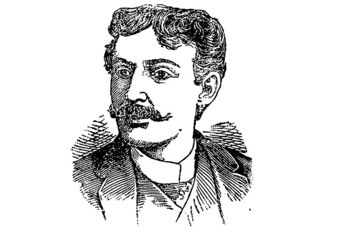Annotation:Climbing Up the Golden Stair: Difference between revisions
(Created page with "=='''Back to [[{{BASEPAGENAME}}]]'''== ---- <p><font face="garamond, serif" size="4"> '''CLIMBING UP THE GOLDEN STAIR'''. Old-Time, Song and Breakdown. D Major. Standard tunin...") |
No edit summary |
||
| (6 intermediate revisions by 2 users not shown) | |||
| Line 1: | Line 1: | ||
---------- | |||
---- | {{TuneAnnotation | ||
|f_tune_annotation_title= https://tunearch.org/wiki/Annotation:Climbing_Up_the_Golden_Stair > | |||
'''CLIMBING UP THE GOLDEN STAIR'''. | |f_annotation='''CLIMBING UP THE GOLDEN STAIR(S)'''. AKA and see "[[Reel à Manda]]," "[[Reel de Pâques]]." American; Song and Reel. D Major. Standard tuning (fiddle). AABB. This air and song, an 1884 composition by F. Heiser, is from the American minstrel repertoire and passed into fiddling tradition. Unfortunately, the words are rather patently racist. "F. Heiser" was a pseudonym for journalist and prolific songwriter Monroe H. Rosenfeld (1861-1918) of Richmond, Virginia, according to Sigmund Spaeth ('''A History of Popular Music''', 1948, p. 231). In addition to his numerous popular songs, Rosenfeld is credited with coining the phrase Tin Pan Alley to describe the world of composers and publishers of popular music. There was a singing dance call to the tune.[[File:rosenfeld.jpg|350px|thumb|right|Monroe Rosenfeld/F. Heiser]] | ||
<blockquote> | <blockquote> | ||
''Come all you little n.....s,'' <br> | ''Come all you little n.....s,'' <br> | ||
| Line 16: | Line 16: | ||
''Climbing up the golden stairs.'' (Ford)<br> | ''Climbing up the golden stairs.'' (Ford)<br> | ||
</blockquote> | </blockquote> | ||
Additional verses are in Ford (1940, p. 284). | Additional verses are in Ford (1940, p. 284). See also Montreal fiddler Isidore Soucy's asymmetrical versions "[[Reel de Pâques]]" and "[[Reel à Manda]]." | ||
|f_source_for_notated_version= | |||
|f_printed_sources=Ford ('''Traditional Music in America'''), 1940; p. 38. Ruth ('''Pioneer Western Folk Tunes'''), 1948; No. 25, p. 10. | |||
|f_recorded_sources=Columbia 146382 (78 RPM), Vernon Dalhart (1928). Topic TSCD 752, Mark Bazeley & Jason Rice - “Stepping Up: A History of the New Wace of English Country Dance Music” (2004). | |||
|f_see_also_listing= | |||
}} | |||
------------- | |||
---- | |||
Latest revision as of 03:20, 25 September 2022
X:1 T:Climbing the Golden Stairs M:2/4 L:1/8 S:Viola "Mom" Ruth - Pioneer Western Folk Tunes (1948) Z:AK/Fiddler's Companion K:D d/d/d/d/ f<a | d/e/d/d/ f<a | d/d/d/d/ fa | e3 (e/f/) | g/f/e/d/ c(e/f/) | g/f/e/d/ ce | a/aa/ ge | d3(3A/B/c/ :| |: dfb>a | a g2- g/g/ | cea>^g | a3 (3A/B/c/ | dfb>a | a g2- g/g/ | a/a/a/a/ ge |1 (d2d) (3A/B/c/:|2 (d2d) ||

Come all you little n.....s,
Now watch your cues and figures,
Climbing up the golden stairs.
If they think you are a dude,
They will treat you rather rude,
Climbing up the golden stairs!
Then hear them bells a-ringing,
'Tis sweet I do declare.
Oh hear them darkies singing,
Climbing up the golden stairs. (Ford)
Additional verses are in Ford (1940, p. 284). See also Montreal fiddler Isidore Soucy's asymmetrical versions "Reel de Pâques" and "Reel à Manda."

